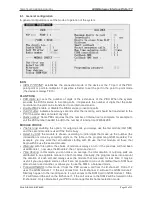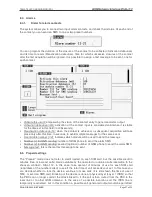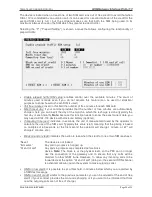
TEMA TELECOMUNICAZIONI SRL
GSM Gateway Interface DIAL-112
MAS-DIAL112-REV06EN
Page 24 of 35
8.2. GSM configuration
In this screen you can run the GSM module configuration (PIN, number of PO, LCR, etc.). And as
you can see these parameters can be customized independently each from other.
•
PIN:
PIN code of the SIM card inserted in the module
•
Operator:
code of the network to be used for the registration of the module. If you do not put
anything in the form, DIAL-112 tries to sign up with your manager on the basis of the SIM and if
not found (for lack of coverage) is in roaming with the operator, which has the strongest signal.
In some cases it may be useful to block the possibility of roaming (i.e. for installations near the
border of the state) to ensure that the module can register with the operators not convenient in
terms of tariffs. For Italy, the operator TIM has code 22201, 22288 Wind, Vodafone 22210 and
22299 3 ITA
•
PO:
enter the number to be dialed to call the PO (if necessary preceded by the root if
requested by the PBX). It is the number that is composed for incoming calls from the GSM.
Some PBXs, when they receive a call from T0 ISDN line, send the call to the PO, if not
provided the number to call (or if you leave this field blank), while others require the provision
of internal extension number to be reached. You can also change the number of PO according
to which SIM is called
•
Volume TX/RX:
set the level of audio signal transmission and reception. TX volume is the
volume of voice output (the sound that reaches the phone of the called party), while the RX is
the volume level of the voice that reaches the internal extension of the ISDN central. You can
enter values from 1 to 12, but in general the optimal level is 9 for both sides
•
Enable incoming calls:
enables the module to receive incoming calls from the GSM network. If
this option is not enabled, any incoming call will be denied
•
Enable outgoing calls:
similarly to incoming calls, it is possible to block outgoing calls (for
example you can block one of the two modules to force calls only on, or block both modules,
and only allow incoming traffic). If you make an outgoing call but no module is available, the
caller will receive a tone of deterrence
•
Calling tone:
this option allows you to send the caller from the internal extension of the PBX
within an alarm tone, indicating that the call was made to the GSM network. The tone is issued
only when sending numbering grid and then only for 3 seconds. Is removed as soon as the
GSM phone call is reached (it starts to ring, it is busy or not answered)
•
Hide CLIP:
if the feature is enabled, the call is forwarded masking the number of SIM card (to
use the Smart callback, you must not hide the number)
•
Use module 2 if busy:
this option is used only if it is used the LCR function on the modules. If
the routing rules provide for a fixed number called the use of some module but the module is












































